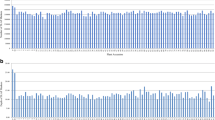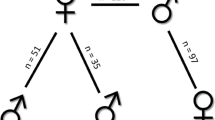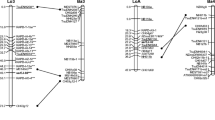Abstract
Poplars (genus Populus) and willows (genus Salix) are members of the Salicaceae, a family of catkin-bearing trees, shrubs and sub-shrubs. Poplar is considered the model system for biological studies in trees and considerable genetic and genomic resources have become available in recent years. The transfer of information to research studies in willow, for which fewer resources are currently available, would be highly beneficial. However, the extent of conservation between poplar and willow genomes has not yet been extensively studied. To address this, we have constructed a linkage map of willow based on a large mapping population derived from a cross between two Salix viminalis × (S. viminalis × S. schwerinii) hybrid sibs, and aligned this to the publicly available poplar genome sequence. A set of genome-wide, expressed poplar sequences was selected and used to design primer sets that efficiently amplified homeologous regions in willow. Direct sequencing of the willow products confirmed homology with the poplar target in the majority of instances and allowed identification of single nucleotide polymorphisms (SNPs) that were used to map these loci. In total, 202 amplified fragment length polymorphisms (AFLPs), 75 microsatellites and 79 SNPs were used to construct a willow consensus map that spanned 1,856.7 cM with an average interval between markers of 6.3 cM. Poplar sequences homologous to those of the mapped willow microsatellite loci were identified and used in addition to the SNP markers to putatively align all but two minor linkage groups to the poplar genome sequence. A high degree of macrosynteny was revealed.


Similar content being viewed by others
References
Altschul SF, Gish W, Miller W, Myers EW, Lipman DJ (1990) Basic local alignment search tool. J Mol Biol 215:403–410
Barker JHA, Matthes M, Arnold GM, Edwards KJ, Åhman I, Larsson S, Karp A (1999) Characterisation of genetic diversity in potential biomass willows (Salix spp.) by RAPD and AFLP analyses. Genome 42:173–183
Barker JHA, Pahlich A, Trybush S, Edwards KJ, Karp A (2003) Microsatellite markers for diverse Salix species. Mol Ecol Notes 3:4–6
Bennetzen JL (2000) Comparative sequence analysis of plant nuclear genomes: microcolinearity and its many exceptions. Plant Cell 12:1021–1029
Blanc G, Wolfe KH (2004) Widespread paleopolyploidy in model plant species inferred from age distributions of duplicate genes. Plant Cell 16:1667–1678
Bradshaw HD Jr, Villar M, Watson BD, Otto KG, Stewart S, Stettler RF (1994) Molecular genetics of growth and development in Populus. III. A genetic linkage map of hybrid poplar composed of RFLP, STS and RAPD markers. Theor Appl Genet 89:167–178
Bradshaw HD, Ceulemans R, Davis J, Stettler R (2000) Emerging model systems in plant biology: Poplar (Populus) as a model forest tree. J Plant Growth Regul 19:306–313
Cato SA, Gardner RC, Kent J, Richardson TE (2001) A rapid PCR-based method for genetically mapping ESTs. Theor Appl Genet 102:296–306
Cervera MT, Storme V, Ivens B, Gusmão J, Liu BH, Hostyn V, Van Slycken M, Van Montague M, Boerjan W (2001) Dense genetic linkage maps of three Populus species (Populus deltoides, P. nigra and P. trichocarpa) based on AFLP and microsatellite markers. Genetics 158:787–809
Chagné D, Brown G, Lalanne C, Madur D, Pot S, Neale D, Plomion C (2003) Comparative genome and QTL mapping between maritime and loblolly pines. Mol Breed 12:185–195
Edwards KJ, Barker JHA, Daly A, Jones C, Karp A (1996) Microsatellite libraries enriched for several microsatellite sequences in plants. Biotechniques 20:758–760
Hanley SJ (2003) Genetic mapping of important agronomic traits in biomass willow. Ph.D. thesis, University of Bristol, UK
Hanley S, Barker JHA, Van Ooijen JW, Aldam C, Harris SL, Åhman I, Larsson S, Karp A (2002) A genetic linkage map of willow (Salix viminalis) based on AFLP and microsatellite markers. Theor Appl Genet 105:1087–1096
Hertzberg M, Aspeborg H, Schrader J, Andersson A, Erlansson R, Blomqvist K, Bhalerao R, Uhlén M, Teeri TT, Lundeberg J, Sundberg B, Nilsson P, Sandberg G (2001) A transcriptional roadmap to wood formation. Proc Natl Acad Sci U S A 98:14732–14737
Kruglyak L (1997) The use of a genetic map of biallelic markers in linkage studies. Nat Genet 138:499–510
Kwok PY, Deng Q, Zakeri H, Taylor SL, Nickerson DA (1996) Increasing the information content of STS-based genome maps: identifying polymorphisms in mapped STSs. Genomics 31:123–126
Maliepaard C, Jansen J, Van Ooijen JW (1997) Linkage analysis in a full-sib family of an outbreeding species: overview and consequences for applications. Genet Res 70:237–250
Paterson AH, Bowers JE, Burow MD, Draye X, Elsik CG, Jiang C-X, Katsar CS, Lan T-H, Lin Y-R, Ming R, Wright RJ (2000) Comparative genomics of plant chromosomes. Plant Cell 12:1523–1539
Rönnberg-Wästljung AC, Tsarouhas V, Semerikov V, Lagercrantz U (2003) A genetic linkage map of a tetraploid Salix viminalis × S. dasyclados hybrid based on AFLP markers. For Genet 10:185–194
Smulders MJM, van der Schoot J, Arens P, Vosman B (2001) Trinucleotide repeat microsatellite markers for black poplar (Populus nigra L.). Mol Ecol Notes 1:188–190
Sterck L, Rombauts S, Jansson S, Sterky F, Rouzé P, Van de Peer Y (2005) EST data suggest that poplar is an ancient polyploid. New Phytol 167:165–170
Sterky F, Regan S, Karlsson J, Hertzberg M, Rohde A, Holmberg A, Amini B, Bhalerao R, Larsson M, Villarroel R, Van Montegu M, Sandberg G, Ollson O, Teeri TT, Boerjan W, Gustafsson P, Uhlén M, Sundberg B, Lundeberg J (1998) Gene discovery in the wood-forming tissues of poplar: analysis of 5,692 expressed sequence tags. P Natl Acad Sci U S A 95:13330–13335
Stirling B, Koo Yang Z, Gunter LE, Tuskan GA, Bradshaw HD Jr (2003) Comparative sequence analysis between orthologous regions of the Arabidopsis and Populus genomes reveals substantial synteny and microcollinearity. Can J For Res 33:2245–2251
Taylor G (2002) Populus: Arabidopsis for forestry. Do we need a model tree? Ann Bot 90:681–689
Tóth G, Gáspári Z, Jurka J (2000) Microsatellites in different eukaryotic genomes: survey and analysis. Genome Res 10:967–981
Tsarouhas V, Gullberg U, Lagercrantz (2002) An AFLP and RFLP linkage map and quantitative trait locus (QTL) analysis of growth traits in Salix. Theor Appl Genet 105:277–288
Tuskan GA, Gunter LE, Yang ZK, Yin TM, Sewell MM, DiFazio SP (2004) Characterization of microsatellites revealed by genomic sequencing of Populus trichocarpa. Can J For Res 34:85–93
van der Schoot J, Popiskova M, Vosman B, Smulders MJM (2000) Development and characterization of microsatellite markers in black poplar (Populus nigra L.). Theor Appl Genet 101:317–322
Van Ooijen JW, Voorrips RE (2001) JoinMap® 3.0, Software for the calculation of genetic linkage maps. Plant Research International, Wageningen, The Netherlands
Voorrips RE (2002) MapChart: software for the graphical representation of linkage maps and QTLs. J Hered 93:77–78
Vos P, Hogers R, Bleeker M, Reijans M, Vandelee T, Hornes M, Frijters A, Pot J, Peleman J, Kuiper M, Zabeau M (1995) AFLP—a new technique for DNA fingerprinting. Nucleic Acids Res 23:4407–4414
Wu RL, Han YF, Hu JJ, Fang KK, Li L, Li ML, Zeng ZB (2000) An integrated genetic map of Populus deltoides based on amplified fragment length polymorphisms. Theor Appl Genet 100:1249–1256
Wullschleger SD, Jansson S, Taylor G (2002) Genomics and forest trees: Populus emerges as the perennial favourite. Plant Cell 14:2651–2655
Yin TM, DiFazio SP, Gunter LE, Riemenschneider S, Tuskan GA (2004) Large-scale heterospecific segregation distortion in Populus revealed by a dense genetic map. Theor Appl Genet 109:451–463
Acknowledgements
This study is part of the BEGIN (Biomass for Energy Genetic Improvement Network) project (bioass4energy.org) funded by the Department of Environment, Food and Rural Affairs (DEFRA) (Project no. NF0424) and the Biotechnology and Biological Sciences Research Council of the United Kingdom. We would like to thank Prof Gail Taylor, University of Southampton, UK for helpful discussions and for providing the poplar leaf material used in this study. Rothamsted Research receives grant-aided support from the Biotechnology and Biological Sciences Research Council of the United Kingdom.
Author information
Authors and Affiliations
Corresponding author
Rights and permissions
About this article
Cite this article
Hanley, S.J., Mallott, M.D. & Karp, A. Alignment of a Salix linkage map to the Populus genomic sequence reveals macrosynteny between willow and poplar genomes. Tree Genetics & Genomes 3, 35–48 (2006). https://doi.org/10.1007/s11295-006-0049-x
Received:
Revised:
Accepted:
Published:
Issue Date:
DOI: https://doi.org/10.1007/s11295-006-0049-x




